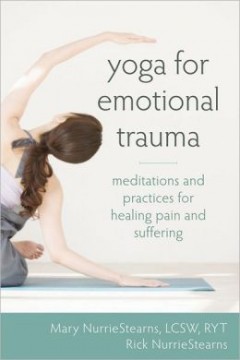
The authors of Yoga for Anxiety have brought us a beautiful book of healing yoga practices for trauma survivors. Not only do they include their own inspiring stories of coming to yoga and meditation to heal, but their prose is full of anecdotes to which readers can readily relate. The NurrieStearns include selfinquiry practices, easy-to-follow guided meditations that anchor the mind with concentration techniques and breath. From the start of the book, the reader is helped to develop an attitude of self-compassion and, the practices, be they postures or simple breathing, are offered with ways to accept yourself as you begin.
In clear and readable prose, the NurrieStearns explain the brain science behind the effects of trauma and how the brain changes with yoga and meditation. My only quibble with this manual of practices, which I do consider essential reading for anyone with a history of trauma, is that the first chapter dives directly into cultivating compassion. Developing compassion for oneself is often the most challenging job for anyone with a history of abuse. The suggestion of selecting a quote or recalling a memory of someone being kind to you may not be sufficient to overcome the strong negative self-talk, self-blame and rumination that often accompanies trauma. While the authors’ suggestions are excellent, in this reviewers opinion, they would better serve the reader if they were introduced later in the book, after some of the physical and breath practices have helped clear away the mind’s distracting thoughts. After a pranayama breathing practice, for example, it is easier for most of us to catch a glimpse of who we are beyond whatever mood is visiting or whatever story we are telling ourselves about our trauma. It is in these moments of expanded awareness that the seeds of compassion can be most effectively nourished. However, don’t neglect this book, just because I think the order might have been different. It’s worthwhile reading for us all.
Accompanying most every suggested practice, there is a helpful section on the science of how the practice effects the body-mind. Whether you come to Yoga for Emotional Trauma for your own healing or because you serve others who suffer from the effects of trauma, keep it near you for inspiration and knowledge. To purchase a copy of Yoga for Emotional Trauma: Meditations and Practices for Healing Pain and Suffering please click here.
 Another resource for mental health and yoga professionals who work with trauma clients is my book Yoga Skills for Therapists which introduces healing professionals to the timeless teachings of yoga that are applicable in a clinical setting — no mat required. As a practical, hands-on guidebook, Yoga Skills offers clinicians the use and proper application of evidence-based Yoga strategies to better serve themselves and their clients in basic mood management and trauma release.
Another resource for mental health and yoga professionals who work with trauma clients is my book Yoga Skills for Therapists which introduces healing professionals to the timeless teachings of yoga that are applicable in a clinical setting — no mat required. As a practical, hands-on guidebook, Yoga Skills offers clinicians the use and proper application of evidence-based Yoga strategies to better serve themselves and their clients in basic mood management and trauma release.
To find a LifeForce Yoga Practitioner in your area visit Yogafordepression.com.
